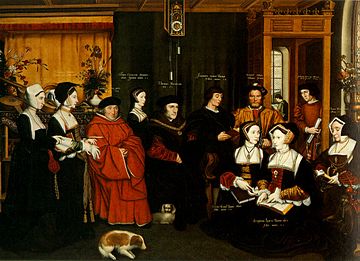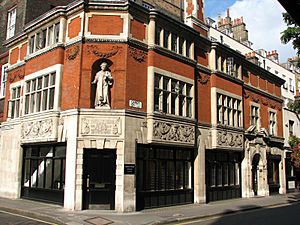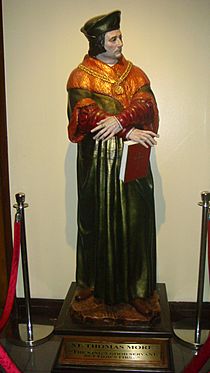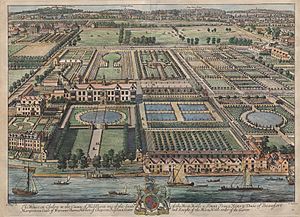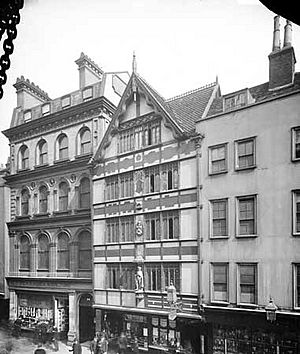Thomas More facts for kids
Quick facts for kids
Thomas More
|
|
|---|---|
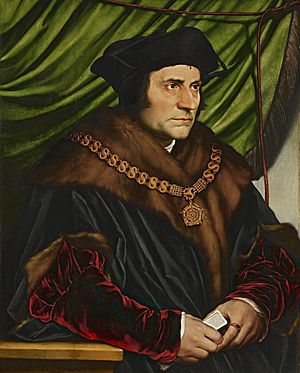
Sir Thomas More (1527)
by Hans Holbein the Younger |
|
| Lord Chancellor | |
| In office October 1529 – May 1532 |
|
| Monarch | Henry VIII |
| Preceded by | Thomas Wolsey |
| Succeeded by | Thomas Audley |
| Chancellor of the Duchy of Lancaster | |
| In office 31 December 1525 – 3 November 1529 |
|
| Monarch | Henry VIII |
| Preceded by | Richard Wingfield |
| Succeeded by | William FitzWilliam |
| Speaker of the House of Commons | |
| In office 15 April 1523 – 13 August 1523 |
|
| Monarch | Henry VIII |
| Preceded by | Thomas Nevill |
| Succeeded by | Thomas Audley |
| Personal details | |
| Born | 7 February 1478 City of London, England |
| Died | 6 July 1535 (aged 57) Tower Hill, London, England |
| Spouses | |
| Children | Margaret, Elizabeth, Cicely, and John |
| Parents | Sir John More Agnes Graunger |
| Education | University of Oxford Lincoln's Inn |
| Signature |  |
|
Philosophy career |
|
|
Notable work
|
Utopia (1516) Responsio ad Lutherum (1523) A Dialogue of Comfort against Tribulation (1553) |
| Era | Renaissance philosophy 16th-century philosophy |
| Region | Western philosophy, Catholic |
| School | Christian humanism Renaissance humanism |
|
Main interests
|
Social philosophy Criticism of Protestantism |
|
Notable ideas
|
Utopia |
|
Influenced
|
|
Sir Thomas More (7 February 1478 – 6 July 1535), venerated in the Catholic Church as Saint Thomas More, was an English lawyer, judge, social philosopher, author, statesman, and noted Renaissance humanist. He also served Henry VIII as Lord High Chancellor of England from October 1529 to May 1532. He wrote Utopia, published in 1516, which describes the political system of an imaginary island state.
More opposed the Protestant Reformation, directing polemics against the theology of Martin Luther, Huldrych Zwingli, John Calvin and William Tyndale. More also opposed Henry VIII's separation from the Catholic Church, refusing to acknowledge Henry as supreme head of the Church of England and the annulment of his marriage to Catherine of Aragon. After refusing to take the Oath of Supremacy, he was convicted of treason and executed. On his execution, he was reported to have said: "I die the King's good servant, and God's first".
Pope Pius XI canonised More in 1935 as a martyr. Pope John Paul II in 2000 declared him the patron saint of statesmen and politicians.
Contents
Early life
Thomas More was born on Milk Street in the City of London, on 7 February 1478. He was the son of Sir John More, a successful lawyer and later a judge, and his wife Agnes (née Graunger). He was the second of six children. More was educated at St. Anthony's School, then considered one of London's best schools. From 1490 to 1492, More served John Morton, the Archbishop of Canterbury and Lord Chancellor of England, as a household page.
Morton enthusiastically supported the "New Learning" (scholarship which was later known as "humanism" or "London humanism"), and thought highly of the young More. Believing that More had great potential, Morton nominated him for a place at the University of Oxford (either in St. Mary Hall or Canterbury College, both now gone).
More began his studies at Oxford in 1492, and received a classical education. Studying under Thomas Linacre and William Grocyn, he became proficient in both Latin and Greek. More left Oxford after only two years—at his father's insistence—to begin legal training in London at New Inn, one of the Inns of Chancery. In 1496, More became a student at Lincoln's Inn, one of the Inns of Court, where he remained until 1502, when he was called to the Bar.
Spiritual life
According to his friend, the theologian Desiderius Erasmus of Rotterdam, More once seriously contemplated abandoning his legal career to become a monk. Between 1503 and 1504 More lived near the Carthusian monastery outside the walls of London and joined in the monks' spiritual exercises. Although he deeply admired their piety, More ultimately decided to remain a layman, standing for election to Parliament in 1504 and marrying the following year.
More continued ascetic practices for the rest of his life, such as wearing a hair shirt next to his skin and occasionally engaging in self-flagellation. A tradition of the Third Order of Saint Francis honours More as a member of that Order on their calendar of saints.
Family life
More married Jane Colt in 1505. In that year he leased a portion of a house known as the Old Barge (originally there had been a wharf nearby serving the Walbrook river) on Bucklersbury, St Stephen Walbrook parish, London. Eight years later he took over the rest of the house and in total he lived there for almost 20 years, until his move to Chelsea in 1525. Erasmus reported that More wanted to give his young wife a better education than she had previously received at home, and tutored her in music and literature. The couple had four children: Margaret, Elizabeth, Cicely, and John. Jane died in 1511.
Going "against friends' advice and common custom," within 30 days, More had married one of the many eligible women among his wide circle of friends. He chose Alice Middleton, a widow, to head his household and care for his small children. The speed of the marriage was so unusual that More had to get a dispensation from the banns of marriage, which, due to his good public reputation, he easily obtained.
More had no children from his second marriage, although he raised Alice's daughter from her previous marriage as his own. More also became the guardian of two young girls: Anne Cresacre who would eventually marry his son, John More; and Margaret Giggs (later Clement) who was the only member of his family to witness his execution (she died on the 35th anniversary of that execution, and her daughter married More's nephew William Rastell). An affectionate father, More wrote letters to his children whenever he was away on legal or government business, and encouraged them to write to him often.
More insisted upon giving his daughters the same classical education as his son, an unusual attitude at the time. His eldest daughter, Margaret, attracted much admiration for her erudition, especially her fluency in Greek and Latin. More told his daughter of his pride in her academic accomplishments in September 1522, after he showed the bishop a letter she had written:
When he saw from the signature that it was the letter of a lady, his surprise led him to read it more eagerly … he said he would never have believed it to be your work unless I had assured him of the fact, and he began to praise it in the highest terms … for its pure Latinity, its correctness, its erudition, and its expressions of tender affection. He took out at once from his pocket a portague [A Portuguese gold coin] … to send to you as a pledge and token of his good will towards you.
More's decision to educate his daughters set an example for other noble families. Even Erasmus became much more favourable once he witnessed their accomplishments.
A portrait of More and his family, Sir Thomas More and Family, was painted by Holbein; however, it was lost in a fire in the 18th century. More's grandson commissioned a copy, of which two versions survive.
Early political career
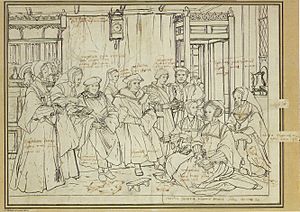
In 1504 More was elected to Parliament to represent Great Yarmouth, and in 1510 began representing London.
From 1510, More served as one of the two undersheriffs of the City of London, a position of considerable responsibility in which he earned a reputation as an honest and effective public servant. More became Master of Requests in 1514, the same year in which he was appointed as a Privy Counsellor. After undertaking a diplomatic mission to the Holy Roman Emperor, Charles V, accompanying Thomas Wolsey, Cardinal Archbishop of York, to Calais and Bruges, More was knighted and made under-treasurer of the Exchequer in 1521.
As secretary and personal adviser to King Henry VIII, More became increasingly influential: welcoming foreign diplomats, drafting official documents, and serving as a liaison between the King and Lord Chancellor Wolsey. More later served as High Steward for the Universities of Oxford and Cambridge.
In 1523 More was elected as knight of the shire (MP) for Middlesex and, on Wolsey's recommendation, the House of Commons elected More its Speaker. In 1525 More became Chancellor of the Duchy of Lancaster, with executive and judicial responsibilities over much of northern England.
Chancellorship
After Wolsey fell, More succeeded to the office of Lord Chancellor in 1529. He dispatched cases with unprecedented rapidity.
Campaign against the Protestant Reformation
More supported the Catholic Church and saw the Protestant Reformation as heresy, a threat to the unity of both church and society.
His early actions against the Protestant Reformation included aiding Wolsey in preventing Lutheran books from being imported into England, spying on and investigating suspected Protestants, especially publishers, and arresting anyone holding in his possession, transporting, or distributing Bibles and other materials of the Protestant Reformation. Additionally, More vigorously suppressed Tyndale's English translation of the New Testament.
Resignation
As the conflict over supremacy between the Papacy and the King reached its peak, More continued to remain steadfast in supporting the supremacy of the Pope as Successor of Peter over that of the King of England. Parliament's reinstatement of the charge of praemunire in 1529 had made it a crime to support in public or office the claim of any authority outside the realm (such as the Papacy) to have a legal jurisdiction superior to the King's.
In 1530, More refused to sign a letter by the leading English churchmen and aristocrats asking Pope Clement VII to annul Henry's marriage to Catherine of Aragon, and also quarrelled with Henry VIII over the heresy laws. In 1531, a royal decree required the clergy to take an oath acknowledging the King as Supreme Head of the Church of England. The bishops at the Convocation of Canterbury in 1532 agreed to sign the Oath but only under threat of praemunire and only after these words were added: "as far as the law of Christ allows".
This was considered to be the final Submission of the Clergy. Cardinal John Fisher and some other clergy refused to sign. Henry purged most clergy who supported the papal stance from senior positions in the church. More continued to refuse to sign the Oath of Supremacy and did not agree to support the annulment of Henry's marriage to Catherine. However, he did not openly reject the King's actions and kept his opinions private.
On 16 May 1532, More resigned from his role as Chancellor but remained in Henry's favour despite his refusal. His decision to resign was caused by the decision of the convocation of the English Church, which was under intense royal threat, on the day before.
Indictment
In 1533, More refused to attend the coronation of Anne Boleyn as the Queen of England. Technically, this was not an act of treason, as More had written to Henry seemingly acknowledging Anne's queenship and expressing his desire for the King's happiness and the new Queen's health. Despite this, his refusal to attend was widely interpreted as a snub against Anne, and Henry took action against him.
Shortly thereafter, More was charged with accepting bribes, but the charges had to be dismissed for lack of any evidence. In early 1534, More was accused by Thomas Cromwell of having given advice and counsel to the "Holy Maid of Kent," Elizabeth Barton, a nun who had prophesied that the king had ruined his soul and would come to a quick end for having divorced Queen Catherine. This was a month after Barton had confessed, which was possibly done under royal pressure, and was said to be concealment of treason.
Though it was dangerous for anyone to have anything to do with Barton, More had indeed met her, and was impressed by her fervour.
On 13 April 1534, More was asked to appear before a commission and swear his allegiance to the parliamentary Act of Succession. More steadfastly refused to take the oath of supremacy of the Crown in the relationship between the kingdom and the church in England. In addition to refusing to support the King's annulment or supremacy, More refused to sign the 1534 Oath of Succession confirming Anne's role as queen and the rights of their children to succession.
His enemies had enough evidence to have the King arrest him on treason. Four days later, Henry had More imprisoned in the Tower of London. There More prepared a devotional Dialogue of Comfort against Tribulation. While More was imprisoned in the Tower, Thomas Cromwell made several visits, urging More to take the oath, which he continued to refuse.
Trial and execution
The trial was held on 1 July 1535, before a panel of judges that included the new Lord Chancellor, Sir Thomas Audley, as well as Anne Boleyn's uncle, Thomas Howard, 3rd Duke of Norfolk, her father Thomas Boleyn and her brother George Boleyn. Norfolk offered More the chance of the king's "gracious pardon" should he "reform his […] obstinate opinion". More responded that, although he had not taken the oath, he had never spoken out against it either and that his silence could be accepted as his "ratification and confirmation" of the new statutes.
Thomas Cromwell, at the time the most powerful of the King's advisors, brought forth Solicitor General Richard Rich to testify that More had, in his presence, denied that the King was the legitimate head of the Church. This testimony was characterised by More as being extremely dubious. Witnesses Richard Southwell and Mr. Palmer (a servant to Southwell) were also present and both denied having heard the details of the reported conversation.
The jury took only fifteen minutes, however, to find More guilty. He was sentenced to be hanged, drawn, and quartered (the usual punishment for traitors who were not the nobility), but the King commuted this to execution by decapitation.
The execution took place on 6 July 1535 at Tower Hill. When he came to mount the steps to the scaffold, its frame seeming so weak that it might collapse, More is widely quoted as saying (to one of the officials): "I pray you, master Lieutenant, see me safe up and [for] my coming down, let me shift for my self"; while on the scaffold he declared "that he died the king's good servant, and God's first." After More had finished reciting the Miserere while kneeling, the executioner reportedly begged his pardon, then More rose up merrily, kissed him and gave him forgiveness.
Correspondence
Most major humanists were prolific letter writers, and Thomas More was no exception. As in the case of his friend Erasmus of Rotterdam, however, only a small portion of his correspondence (about 280 letters) survived. These include everything from personal letters to official government correspondence (mostly in English), letters to fellow humanist scholars (in Latin), several epistolary tracts, verse epistles, prefatory letters (some fictional) to several of More's own works, letters to More's children and their tutors (in Latin), and the so-called "prison-letters" (in English) which he exchanged with his oldest daughter Margaret while he was imprisoned in the Tower of London awaiting execution. More also engaged in controversies, most notably with the French poet Germain de Brie, which culminated in the publication of de Brie's Antimorus (1519). Erasmus intervened, however, and ended the dispute.
More also wrote about more spiritual matters. They include: A Treatise on the Passion (a.k.a. Treatise on the Passion of Christ), A Treatise to Receive the Blessed Body (a.k.a. Holy Body Treaty), and De Tristitia Christi (a.k.a. The Agony of Christ). More handwrote the last in the Tower of London while awaiting his execution. This last manuscript, saved from the confiscation decreed by Henry VIII, passed by the will of his daughter Margaret to Spanish hands through Fray Pedro de Soto, confessor of Emperor Charles V. More's friend Luis Vives received it in Valencia, where it remains in the collection of Real Colegio Seminario del Corpus Christi museum.
Veneration
| Saint Thomas More |
|
|---|---|
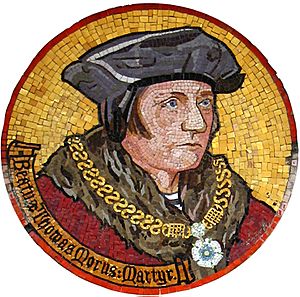
Portrait of Saint Thomas More, executed on Tower Hill (London) in 1535, apparently based on the Holbein portrait.
|
|
| Reformation Martyr, Scholar | |
| Venerated in | Catholic Church Anglican Communion |
| Beatified | 29 December 1886, Florence, Kingdom of Italy, by Pope Leo XIII |
| Canonized | 19 May 1935, Vatican City, by Pope Pius XI |
| Major shrine | Church of St Peter ad Vincula, London, England |
| Feast | 22 June (Catholic Church) 6 July (Church of England) 9 July (Catholic Extraordinary Form) |
| Attributes | dressed in the robe of the Chancellor and wearing the Collar of Esses; axe |
| Patronage | Statesmen and politicians; lawyers; Ateneo de Manila Law School; Diocese of Arlington; Diocese of Pensacola-Tallahassee; Kerala Catholic Youth Movement; University of Malta; University of Santo Tomas Faculty of Arts and Letters |
Catholic Church
Pope Leo XIII beatified Thomas More, John Fisher, and 52 other English Martyrs on 29 December 1886. Pope Pius XI canonised More and Fisher on 19 May 1935, and More's feast day was established as 9 July. Since 1970 the General Roman Calendar has celebrated More with St John Fisher on 22 June (the date of Fisher's execution). On 31 October 2000 Pope John Paul II declared More "the heavenly Patron of Statesmen and Politicians". More is the patron of the German Catholic youth organisation Katholische Junge Gemeinde.
Anglican Communion
In 1980, despite their opposition to the English Reformation, More and Fisher were added as martyrs of the reformation to the Church of England's calendar of "Saints and Heroes of the Christian Church", to be commemorated every 6 July (the date of More's execution) as "Thomas More, scholar, and John Fisher, Bishop of Rochester, Reformation Martyrs, 1535". The annual remembrance of 6 July, is recognized by all Anglican Churches in communion with Canterbury, including Australia, Brazil, Canada, and South Africa.
In an essay examining the events around the addition to the Anglican calendar, Scholar William Sheils links the reasoning for More's recognition to a "long-standing tradition hinted at in Rose Macaulay's ironic debating point of 1935 about More's status as an 'unschismed Anglican', a tradition also recalled in the annual memorial lecture held at St. Dunstan's Church in Canterbury, where More's head is said to be buried." Sheils also noted the influence of the 1960s popular play and film A Man for All Seasons which gave More a 'reputation as a defender of the right of conscience". Thanks to the play's depiction, this "brought his life to a broader and more popular audience" with the film "extending its impact worldwide following the Oscar triumphs". Around this time the atheist Oxford historian and public intellectual, Hugh Trevor-Roper held More up as "the first great Englishman whom we feel that we know, the most saintly of Humanists...the universal man of our cool northern Renaissance." By 1978, the quincentenary of More's birth Trevor-Roper wrote an essay putting More in the Renaissance Platonist tradition, and claim his reputation was "quite independent of his Catholicism." (Only, later on, did a more critical view arise in academia, led by Professor Sir Geoffrey Elton, which "challenged More's reputation for saintliness by focusing on his dealings with heretics, the ferocity of which, in fairness to him, More did not deny. In this research, More's role as a prosecutor, or persecutor, of dissidents has been at the center of the debate.")
Legacy
The steadfastness and courage with which More maintained his religious convictions, and his dignity during his imprisonment, trial, and execution, contributed much to More's posthumous reputation, particularly among Roman Catholics. His friend Erasmus defended More's character as "more pure than any snow" and described his genius as "such as England never had and never again will have." Upon learning of More's execution, Emperor Charles V said: "Had we been master of such a servant, we would rather have lost the best city of our dominions than such a worthy councillor."
G. K. Chesterton, a Roman Catholic convert from the Church of England, predicted More "may come to be counted the greatest Englishman, or at least the greatest historical character in English history." Hugh Trevor-Roper called More "the first great Englishman whom we feel that we know, the most saintly of humanists, the most human of saints, the universal man of our cool northern renaissance."
Jonathan Swift, an Anglican, wrote that More was "a person of the greatest virtue this kingdom ever produced". Some consider Samuel Johnson that quote's author, although neither his writings nor Boswell's contain such. The metaphysical poet John Donne, also honoured as a hero by Anglicans, was More's great-great-nephew. US Senator Eugene McCarthy had a portrait of More in his office.
Roman Catholic scholars maintain that More used irony in Utopia, and that he remained an orthodox Christian. Marxist theoreticians such as Karl Kautsky considered the book a critique of economic and social exploitation in pre-modern Europe and More is claimed to have influenced the development of socialist ideas.
In 1963, Moreana, an academic journal focusing on analysis of More and his writings, was founded.
In 2002, More was placed at number 37 in the BBC's poll of the 100 Greatest Britons.
In literature and popular culture
William Roper's biography of More was one of the first biographies in Modern English.
Sir Thomas More is a play written circa 1592 in collaboration between Henry Chettle, Anthony Munday, William Shakespeare, and others. In it More is portrayed as a wise and honest statesman. The original manuscript has survived as a handwritten text that shows many revisions by its several authors, as well as the censorious influence of Edmund Tylney, Master of the Revels in the government of Queen Elizabeth I. The script has since been published and has had several productions.
The 20th-century agnostic playwright Robert Bolt portrayed Thomas More as the tragic hero of his 1960 play A Man for All Seasons. The title is drawn from what Robert Whittington in 1520 wrote of More:
More is a man of an angel's wit and singular learning. I know not his fellow. For where is the man of that gentleness, lowliness and affability? And, as time requireth, a man of marvelous mirth and pastimes, and sometime of as sad gravity. A man for all seasons.
In 1966, the play A Man for All Seasons was adapted into a film with the same title. It was directed by Fred Zinnemann and adapted for the screen by the playwright. It stars Paul Scofield, a noted British actor, who said that the part of Sir Thomas More was "the most difficult part I played." The film won the Academy Award for Best Picture and Scofield won the Best Actor Oscar. In 1988 Charlton Heston starred in and directed a made-for-television film that restored the character of "the common man" that had been cut from the 1966 film.
In the 1969 film Anne of the Thousand Days, More is portrayed by actor William Squire.
Catholic science fiction writer R. A. Lafferty wrote his novel Past Master as a modern equivalent to More's Utopia, which he saw as a satire. In this novel, Thomas More travels through time to the year 2535, where he is made king of the world "Astrobe", only to be beheaded after ruling for a mere nine days. One character compares More favourably to almost every other major historical figure: "He had one completely honest moment right at the end. I cannot think of anyone else who ever had one."
Karl Zuchardt's novel, Stirb du Narr! ("Die you fool!"), about More's struggle with King Henry, portrays More as an idealist bound to fail in the power struggle with a ruthless ruler and an unjust world.
In her 2009 novel Wolf Hall, its 2012 sequel Bring Up the Bodies, and the final book of the trilogy, her 2020 The Mirror and the Light, the novelist Hilary Mantel portrays More (from the perspective of a sympathetically portrayed Thomas Cromwell) as an unsympathetic persecutor of Protestants and an ally of the Habsburg empire.
Literary critic James Wood in his book The Broken Estate, a collection of essays, is critical of More and refers to him as "cruel in punishment, evasive in argument, lusty for power, and repressive in politics".
Aaron Zelman's non-fiction book The State Versus the People includes a comparison of Utopia with Plato's Republic. Zelman is undecided as to whether More was being ironic in his book or was genuinely advocating a police state. Zelman comments, "More is the only Christian saint to be honoured with a statue at the Kremlin." By this Zelman implies that Utopia influenced Vladimir Lenin's Bolsheviks, despite their brutal repression of religion.
Other biographers, such as Peter Ackroyd, have offered a more sympathetic picture of More as both a sophisticated philosopher and man of letters, as well as a zealous Catholic who believed in the authority of the Holy See over Christendom.
The protagonist of Walker Percy's novels, Love in the Ruins and The Thanatos Syndrome, is "Dr Thomas More", a reluctant Catholic and descendant of More.
More is the focus of the Al Stewart song "A Man For All Seasons" from the 1978 album Time Passages, and of the Far song "Sir", featured on the limited editions and 2008 re-release of their 1994 album Quick. In addition, the song "So Says I" by indie rock outfit The Shins alludes to the socialist interpretation of More's Utopia.
Jeremy Northam depicts More in the television series The Tudors as a peaceful man, as well as a devout Roman Catholic and loving family patriarch. He also shows More loathing Protestantism, burning both Martin Luther's books and English Protestants who have been convicted of heresy. The portrayal has unhistorical aspects, such as that More neither personally caused nor attended Simon Fish's execution (since Fish actually died of bubonic plague in 1531 before he could stand trial), although More's The Supplication of Souls, published in October 1529, addressed Fish's Supplication for the Beggars. Indeed, there is no evidence that More ever attended the execution of any heretic. The series also neglected to show More's avowed insistence that Richard Rich's testimony about More disputing the King's title as Supreme Head of the Church of England was perjured.
More is depicted by Andrew Buchan in the television series The Spanish Princess.
In the years 1968–2007 the University of San Francisco's Gleeson Library Associates awarded the annual Sir Thomas More Medal for Book Collecting to private book collectors of note, including Elmer Belt, Otto Schaefer, Albert Sperisen, John S. Mayfield and Lord Wardington.
Historic sites
Westminster Hall
A plaque in the middle of the floor of London's Westminster Hall commemorates More's trial for treason and condemnation to execution in that original part of the Palace of Westminster. The building, which houses Parliament, would have been well known to More, who served several terms as a member and became Speaker of the House of Commons before his appointment as England's Lord Chancellor.
Beaufort House
As More's royal duties frequently required his attendance at the king's Thames-side palaces in both Richmond and Greenwich, it was convenient to select a riverside property situated between them (the common method of transport being by boat) for his home. In about 1520 he purchased a parcel of land comprising "undisturbed wood and pasture", stretching from the Thames in Chelsea to the present-day King's Road. There he caused to be built a dignified red-brick mansion (known simply as More's house or Chelsea House) in which he lived until his arrest in 1534.
Upon More's arrest the estate was confiscated, coming into the possession of the Comptroller of the Royal Household, William Paulet.
In 1682, the property was renamed Beaufort House after 1st Duke of Beaufort, a new owner.
Crosby Hall
In June 1523 More bought the "very large and beautiful" Crosby Place (Crosby Hall) in Bishopsgate, London, but this was not a simple transaction: eight months later he sold the property (never having lived there) at a considerable profit to his friend and business partner Antonio Bonvisi who, in turn, leased it back to More's son-in-law William Roper and nephew William Rastell; possibly this was an agreed means of dealing with a debt between More and Bonvisi. Because of this the Crown did not confiscate the property after More's execution.
Chelsea Old Church
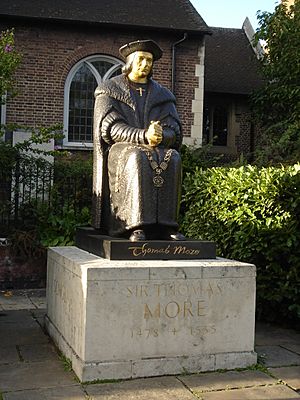
Across a small park and Old Church Street from Crosby Hall is Chelsea Old Church, an Anglican church whose southern chapel More commissioned and in which he sang with the parish choir. Except for his chapel, the church was largely destroyed in the Second World War and rebuilt in 1958. The capitals on the medieval arch connecting the chapel to the main sanctuary display symbols associated with More and his office. On the southern wall of the sanctuary is the tomb and epitaph he erected for himself and his wives, detailing his ancestry and accomplishments in Latin, including his role as peacemaker between the various Christian European states as well as a curiously altered portion about his curbing heresy. When More served Mass, he would leave by the door just to the left of it. He is not, however, buried here, nor is it entirely certain which of his family may be. It is open to the public at specific times. Outside the church, facing the River Thames, is a statue by L. Cubitt Bevis erected in 1969, commemorating More as "saint", "scholar", and "statesman"; the back displays his coat-of-arms. Nearby, on Upper Cheyne Row, the Roman Catholic Church of Our Most Holy Redeemer & St. Thomas More honours the martyr.
Tower Hill
A plaque and small garden commemorate the famed execution site on Tower Hill, London, just outside the Tower of London, as well as all those executed there, many as religious martyrs or as prisoners of conscience. More's corpse, minus his head, was unceremoniously buried in an unmarked mass grave beneath the Royal Chapel of St. Peter Ad Vincula, within the walls of the Tower of London, as was the custom for traitors executed at Tower Hill. The chapel is accessible to Tower visitors.
St Katharine Docks
Thomas More is commemorated by a stone plaque near St Katharine Docks, just east of the Tower where he was executed. The street in which it is situated was formerly called Nightingale Lane, a corruption of "Knighten Guild", derived from the original owners of the land. It is now renamed Thomas More Street in his honour.
St Dunstan's Church and Roper House, Canterbury
St Dunstan's Church, an Anglican parish church in Canterbury, possesses More's head, rescued by his daughter Margaret Roper, whose family lived in Canterbury down and across the street from their parish church. A stone immediately to the left of the altar marks the sealed Roper family vault beneath the Nicholas Chapel, itself to the right of the church's sanctuary or main altar. St Dunstan's Church has carefully investigated, preserved and sealed this burial vault. The last archaeological investigation revealed that the suspected head of More rests in a niche separate from the other bodies, possibly from later interference. Displays in the chapel record the archaeological findings in pictures and narratives. Roman Catholics donated stained glass to commemorate the events in More's life. A small plaque marks the former home of William and Margaret Roper; another house nearby and entitled Roper House is now a home for deaf people.
Works
Note: The reference "CW" is to the relevant volume of the Yale Edition of the Complete Works of St. Thomas More (New Haven and London 1963–1997)
Published during More's life (with dates of publication)
- A Merry Jest (c. 1516) (CW 1)
- Utopia (1516) (CW 4)
- Latin Poems (1518, 1520) (CW 3, Pt.2)
- Letter to Brixius (1520) (CW 3, Pt. 2, App C)
- Responsio ad Lutherum (The Answer to Luther, 1523) (CW 5)
- A Dialogue Concerning Heresies (1529, 1530) (CW 6)
- Supplication of Souls (1529) (CW 7)
- Letter Against Frith (1532) (CW 7) pdf
- The Confutation of Tyndale's Answer (1532, 1533) (CW 8) Books 1–4, Books 5–9
- Apology (1533) (CW 9)
- Debellation of Salem and Bizance (1533) (CW 10) pdf
- The Answer to a Poisoned Book (1533) (CW 11) pdf
Published after More's death (with likely dates of composition)
- The History of King Richard III (c. 1513–1518) (CW 2 & 15)
- The Four Last Things (c. 1522) (CW 1)
- A Dialogue of Comfort Against Tribulation (1534) (CW 12)
- Treatise Upon the Passion (1534) (CW 13)
- Treatise on the Blessed Body (1535) (CW 13)
- Instructions and Prayers (1535) (CW 13)
- De Tristitia Christi (1535) (CW 14) (preserved in the Real Colegio Seminario del Corpus Christi, Valencia)
Translations
- Translations of Lucian (many dates 1506–1534) (CW 3, Pt.1)
- The Life of Pico della Mirandola, by Gianfrancesco Pico della Mirandola (c. 1510) (CW 1)
See also
 In Spanish: Tomás Moro para niños
In Spanish: Tomás Moro para niños


